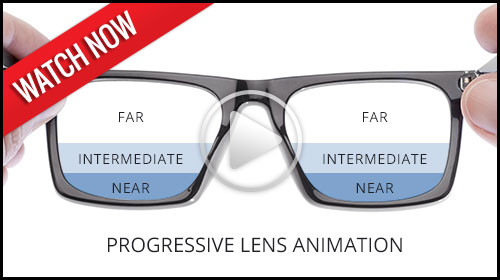Blog
A quick explanation and background of a progressive addition lens is necessary in order to understand the importance of choosing the proper lens for your needs.
A progressive lens gives people an array of prescriptions - placed in the proper positions throughout the lens - to best imitate normal vision. Imagine having the precise correction needed to see a television screen more than 15 feet from you, while reading this article on your desktop computer, and then looking down at your keyboard in order to start entering the address to your favorite website. This, in a nutshell, is exactly what the progressive lens is ideally capable of accomplishing with one pair of glasses.
 Having the least amount of peripheral distortion, and one of the wider ranges in both distance power, astigmatism, prism, and add power availability, we find this lens to be very versatile. The most important thing to you is that this product feels very natural in front of your eye. For first-time progressive lens wearers, there is a stigma that it takes a bit of time to adjust to a lens that holds multiple prescriptions. This is often still an issue if places use old technology lenses or don’t take careful measurements to assure the proper placement on the lens in the frame. However, with modern technology, the use of computers to fine tune this amazing product, and careful measurements and lens positioning by your optician, this lens does the best job we have seen in mimicking perfect 20/20 vision at all focal lengths.
Having the least amount of peripheral distortion, and one of the wider ranges in both distance power, astigmatism, prism, and add power availability, we find this lens to be very versatile. The most important thing to you is that this product feels very natural in front of your eye. For first-time progressive lens wearers, there is a stigma that it takes a bit of time to adjust to a lens that holds multiple prescriptions. This is often still an issue if places use old technology lenses or don’t take careful measurements to assure the proper placement on the lens in the frame. However, with modern technology, the use of computers to fine tune this amazing product, and careful measurements and lens positioning by your optician, this lens does the best job we have seen in mimicking perfect 20/20 vision at all focal lengths.
Along with the progressive lens itself, there are other additional treatments, or “add-ons” that can immensely improve one’s experience with their glasses. These products will be touched upon in future articles in more depth, but options such as Transition Photochromic application, Anti-Reflective Coatings, and choosing a Polycarbonate scratch-resistant lens are just a few of the more popular choices.
So when making a decision for your next pair of eyeglasses, please understand this: Vision is an incredibly important aspect of daily life, and it should be treated with the utmost care and importance. Along with keeping up with your yearly examinations, make sure you are treating your eyes properly when it comes to your decisions for corrective lenses.
Article contributed by Richard Striffolino Jr.
The content of this blog cannot be reproduced or duplicated without the express written consent of Eye IQ
Have you ever seen a temporary black spot in your vision? How about jagged white lines? Something that looks like heat waves shimmering in your peripheral vision?
If you have, you may have been experiencing what is known as an ocular migraine. Ocular migraines occur when blood vessels spasm in the visual center of the brain (the occipital lobe) or the retina.
They can take on several different symptoms but typically last from a few minutes to an hour. They can take on either positive or negative visual symptoms, meaning they can produce what looks like a black blocked-out area in your vision (negative symptom), or they can produce visual symptoms that you see but know aren’t really there, like heat waves or jagged white lines that look almost like lightning streaks (positive symptoms).
Some people do get a headache after the visual symptoms but most do not. They get the visual symptoms, which resolve on their own in under an hour, and then generally just feel slightly out of sorts after the episode but don’t get a significant headache. The majority of episodes last about 20 minutes but can go on for an hour. The hallmark of this problem is that once the visual phenomenon resolves the vision returns completely back to normal with no residual change or defect.
If you have this happen for the first time it can be scary and it is a good idea to have a thorough eye exam by your ophthalmologist or optometrist soon after the episode to be sure there is nothing else causing the problem.
Many people who get ocular migraines tend to have them occur in clusters. They will have three or four episodes within a week and then may not have another one for several months or even years.
There are some characteristics that raise your risk for ocular migraines. The biggest one is a personal history of having migraine headaches. Having a family history of migraines also raises your risk, as does a history of motion sickness.
Although the symptoms can cause a great deal of anxiety, especially on the first occurrence, ocular migraines rarely cause any long-term problems and almost never require treatment as long as they are not accompanied by significant headaches.
So if symptoms like this suddenly occur in your vision, try to remain calm, pull over if you are driving, and wait for them to go away. If they persist for longer than an hour, you should seek immediate medical attention.
Article contributed by Dr. Brian Wnorowski, M.D.
The content of this blog cannot be reproduced or duplicated without the express written consent of Eye IQ
Read more: I'm seeing jagged lines in my vision, what is it?














